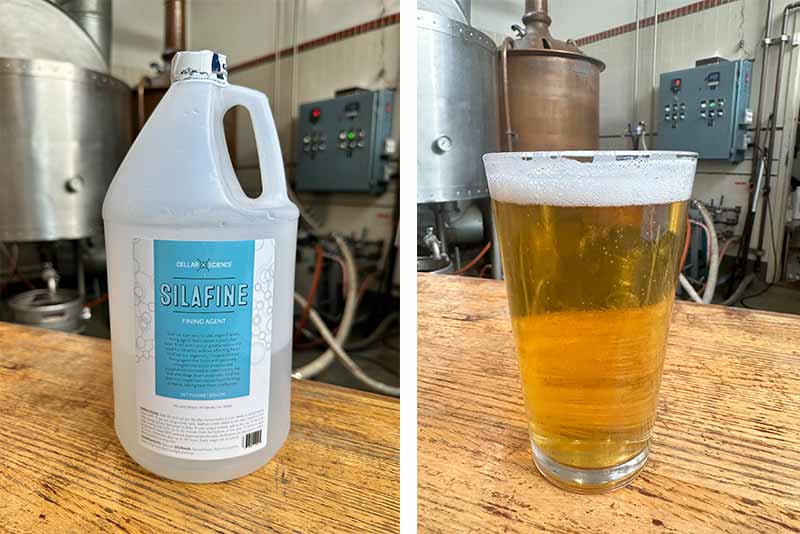
We’ve covered the benefits of using a centrifuge. And while all breweries would love the ability to use this piece of equipment, even the smallest one can be a tad steep for the budget.
Luckily, there are ways to get crystal clear beer without breaking the bank. We chatted with More Beer, BSG, and North Park Beer Company about the cost-effective ways to clarify beer, how to use them, and just how much money you’ll save in the process.
(Above photography courtesy of Colin Kaminski | MoreBeer)
What We’ll Cover in This Piece:
Affordable, Industry-Leading Brewery Software
What Is a Cost-Effective Alternative to Clarify Beer?

Photography courtesy of Brülosophy
BSG Product Portfolio Manager and Commercial Hop Specialist Matt Johnson, who previously served as brewmaster at Karl Strauss for more than a decade, says using fining agents is an excellent way to clarify beer.
“We used it at Strauss when I was there, even though we had a centrifuge,” Johnson says. “It’s a good way if you want to take away taste-forming particles.”
BSG offers the fining agent Biofine® Clear in its portfolio of products. That is the preferred fining agent at North Park, Founder and Head Brewer Kelsey McNair says. Johnson says Biofine does wonders on lagers and West Coast-style IPAs.
“It really clears up your beer,” Johnson says. “If you don’t want to do it the centrifuge way, this is a way to do it. It comes out great.”
More Beer R&D Designer Colin Kaminski says that clarifying beer depends on the type of haze, noting that mineral and starch hazes are problematic concerning clearing up beer.
“If you have your brewing practices together, you will run into protein, yeast, and hop hazes,” Kaminski says. “When we are fining, we take advantage of Stokes’ Law.”
Stokes’ Law is an equation that expresses the drag force resisting the fall of small spherical particles through a fluid medium.
“Without getting into the math, you have the option to make particles larger or heavier,” Kaminski says. “Fining agents exist to do both. Sometimes, they are combined.”
More Beer carries Biofine as well as the CellarScience® SilaFine fining agent. Kaminski says the two products are pretty close in use, but Biofine remains the top seller on their site because it has been available longer. And while the fining agents are popular for their ease of use, Kaminski says there are alternatives to those.
“There are other finings that should not be overlooked for some applications, including PVPP, Isinglass, Gelatin, and even egg white, which is commonly used,” Kaminski says.
How Do You Use Fining Agents?

Photography courtesy of BSG
“Dose it when you fill the brite tank,” Johnson says. “Inline dosing is probably the best.”
Dosing should be anywhere from two hundred to two thousand ppm and ideally should be done in bench trials to see what works best for each style. Johnson notes that you can also drop it at the top of the tank, but be sure to blast the tank with CO2 and mix it thoroughly.
“The better it is mixed, the quicker and better it’ll work for you,” Johnson says.
McNair says that initially, they’ll use BSG’s Whirlfloc G, a granular fining agent that helps with wort and beer clarity, on the hot side at the tail end of the boil to coagulate protein, hops, trub, and break material to leave behind in the kettle after whirlpooling.
Then, adding the fining agent depends on the beer recipe and style.
“We have the best results when doing bench trials on known recipes and determining the amount needed,” McNair says.
Kaminski says it’s best to introduce finings by pushing it slowly from a pressurized container into a transfer.
“However, it is common to put the finings into the receiving tank before the transfer and allow it to mix in while filling,” Kaminski says.
North Park adds Biofine Clear to the tank when the beer is around 33 degrees Fahrenheit, but McNair says if they could get the beer colder, they would.
“We will bubble CO2 from the carb stone and then pour the Biofine Clear in through the dry hop port directly into the stream of bubbles,” McNair explains.
Kaminski points out that fining at a temperature warmer than the serving temperature can create a chill haze, which appears when the beer is cold and disappears as the beer warms,” he says. “The better you mix, the more effective it is.”
Johnson says to get the beer as cold as possible—but at least 38 degrees Fahrenheit—before dosing.
“This is pre-carbonation,” Johnson says. “I don’t think mixing the fining agent with [the] carb stone is a bad way of doing it. If you use the carb stone, I would bubble through the bottom to make sure the bottom is mixing in good though.”
Kaminski adds that knowing what is causing the haze will help with choosing the proper finings.
“Using an Imhoff cone, you can find out if a fining agent will work on your haze,” he says. “However, an Imhoff cone is ineffective at calculating required dosages because the dosage will increase as the surface area-to-volume ratio of the tank increases.”
For SilaFine, a good starting point for dosing is ten to twenty milliliters per barrel. Depending on the tank size, SilaFine will vary in its clarification. Kaminski says the beer will clear in the tank at six inches per hour if dosed properly.
“Some hazes will completely clarify,” he says.
McNair says they dose with Biofine Clear as high as one hundred and fifty grams per barrel right after the beer is completely crashed out but just before carbonating. McNair says the dosage rate really depends on the recipe.
“Lagers and heavily dry-hopped beers tend to need a very high dosing rate,” McNair says. “Some hops—particularly Southern Hemisphere varieties—bring a heavier load of polyphenols, and those tend to require the highest dosing rates.”
McNair says the beer clarifies from the fining agent after anywhere from twenty-four to seventy-two hours.
“In many cases, we can achieve a very polished, filtered-like appearance,” McNair says.
Johnson agrees to definitely give your beer time.
“I wouldn’t do anything less than twenty-four hours,” he says. “If it’s dispersed in the tank well, it will do what it needs in the timeframe. If you can do more than forty-eight hours, I would do that.”
What Are the Advantages of Fining Agents?

Photography courtesy of Cellar Science
“I don’t want to say it’s foolproof,” Johnson says, “but it’s really easy to use.”
McNair says fining agents simplify things.
“For beers that we want to be bright, crisp, and have a filtered-like character without actually using a filter, we can achieve this with fining agents,” he says.
McNair adds, “We can also add cold-side fining agents in a uni-tank rather than transferring from the fermenter to the brite tank with a secondary clarification process in between, such as a centrifuge or filter.”
Kaminski echoes McNair’s sentiment.
“They are effective and inexpensive,” he says. “Most are easy to introduce to the beer.”
Adds Johnson, “It clears up beer pretty good, it’s very cost-effective, and can help with overall recovery out of the brite tank.”
How Much Cost Savings Is There with Fining Agents?
“Immense cost savings,” Johnson says flatly.
Even at the top dosage rate, fining agents are relatively inexpensive. Johnson cautions that consistency may be an issue at larger operations, especially for distribution.
“If you are a smaller operation, you can do a great job at maximizing your profit and increase your yield and get really nice clarity using just fining agents,” Johnson says.
Kaminski says there are multiple factors in calculating the cost-savings through fining.
“Fining agents can improve the yield from a tank by compacting the sediment, allowing more to be racked from the top,” he says. “The extra yield can be difficult to calculate and is very recipe dependent.”
He adds, “The other hard-to-calculate benefit is the customer appreciation from a clear beer… [and] the improved shelf stability, but that is an important factor in clarifying a beer.”
McNair doesn’t view fining agents as a means to get greater yield. He says that although a centrifuge is a costly piece of equipment that requires a lot of maintenance, it will pay for itself in greater yields per batch. He says the capital outlay is way less if you’re using fining agents instead of a centrifuge, but you’ll get less beer.
“With a filter or a centrifuge, both are mechanical processes that take time to operate and will add some labor costs,” McNair says. “Using finings doesn’t require much labor aside from the dosing application, which simply takes a few minutes, and then just letting the fining agent do its work over the next day or two.”
Are There Any Downsides to Fining Agents?

Photography courtesy of BSG
Kaminski says that if you are not filtering after using a fining agent, you must be careful which one you use.
“You will need to consult the datasheets to be sure,” Kaminski says.
Kaminski adds that the fining agents could be less effective in packaged beer.
“If you fine a keg and then ship it, the motion can make some finings ineffective,” he says.
Johnson says haze can come through if you don’t dial in on dosing. That all depends on style, too.
“If you do a red, and you used a little colored malt—crystal or something with a different protein, or wheat to enhance head retention—that’s what I mean about haze potential in the finished beer,” Johnson says. “If you use oats for added mouthfeel, thickness, or sweetness, that can add to it as well. That’s a range. The brewer needs to dial that in for their beer in their brewery.”
He adds, “Once you dial it in, these agents are really effective in taking out these yeasts.”
McNair says he has noticed there can be some minor aroma loss or reduced head retention when using some fining agents.
“We can make up for the loss of aroma by simply using more hops,” McNair says.
Kaminski adds that the fining agent doesn’t add any flavors but can sometimes remove flavor.
“Specifically some of the polyphenol-derived hop flavors,” he says.
Should You Invest in a Centrifuge or Use Fining Agents?
Kaminski calls the centrifuge the gold standard in clarifying beer because you don’t introduce anything to the beer. Filtration and fining are not mutually exclusive, though. He says that often fining can make filtration more effective.
“Filtration can introduce oxygen and/or iron to the beer, so it must be done with best practices,” Kaminski says. “Finings can also introduce oxygen, so your dilution water, if needed, must be de-aerated.”
McNair says that fining agents, while cost-effective, won’t result in a greater yield the way that a centrifuge or a filter will.
“You have more precise control over the amount of solids removed with a centrifuge, whereas there are limiting factors with fining agents,” McNair says. “Some cold-side fining agents can become less effective if you go beyond their recommended dosing rate and actually cause a higher level of turbidity.”
Johnson says that filtration can still lead to haze and might not be as clear as fining. He says centrifuges allow brewers to adjust turbidity levels, but depending on how clear you’re trying to make the beer, the centrifuging process takes longer. Combining fining with either is a great method for clarifying beer if you have the means.
“I’ve used a centrifuge and used finings before using the centrifuge to have it be quicker in the centrifuge,” Johnson says. “Finings by themselves work great; used in conjunction with others is great because it reduces time to get to [the] preferred clarity level.”



